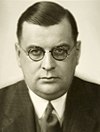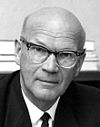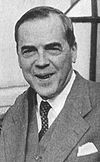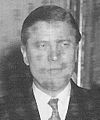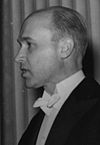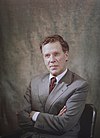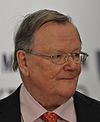| No. | Portrait | Minister | Took office | Left office | Time in office | Party | Cabinet |
|---|
| 1 | | Otto Stenroth
(1861–1939) | 27 May 1918 | 27 November 1918 | 184 days | Young Finnish | Paasikivi I |
| 2 | | Carl Enckell
(1876–1959) | 27 November 1918 | 28 April 1919 | 152 days | Independent | Ingman I
K. Castrén |
| 3 | | Rudolf Holsti
(1881–1945) | 28 April 1919 | 20 May 1922 | 3 years, 22 days | National Progressive | K. Castrén
Vennola I
Erich
Vennola II |
| (2) | | Carl Enckell
(1876–1959) | 2 June 1922 | 14 November 1922 | 165 days | Independent | Cajander I |
| 4 | | Juho Vennola
(1872–1938) | 14 November 1922 | 18 January 1924 | 1 year, 65 days | National Progressive | Kallio I |
| (2) | | Carl Enckell
(1876–1959) | 18 January 1924 | 31 May 1924 | 134 days | Independent | Cajander II |
| 5 | | Hjalmar Procopé
(1889–1954) | 31 May 1924 | 31 March 1925 | 304 days | RKP | Ingman II |
| 6 | | Gustaf Idman
(1885–1961) | 31 March 1925 | 31 December 1925 | 275 days | Independent | Tulenheimo |
| 7 | | Emil Nestor Setälä
(1864–1935) | 31 December 1925 | 13 December 1926 | 347 days | National Coalition | Kallio II |
| 8 | | Väinö Voionmaa
(1869–1947) | 13 December 1926 | 17 December 1927 | 1 year, 4 days | SDP | Tanner |
| (5) | | Hjalmar Procopé
(1889–1954) | 17 December 1927 | 21 March 1931 | 3 years, 94 days | Independent | Sunila I
Mantere
Kallio III
Svinhufvud II |
| 9 | | Aarno Yrjö-Koskinen
(1885–1951) | 21 March 1931 | 14 December 1932 | 1 year, 268 days | National Coalition | Sunila II |
| 10 | | Antti Hackzell
(1881–1946) | 14 December 1932 | 7 October 1936 | 3 years, 298 days | Independent | Kivimäki |
| (3) | | Rudolf Holsti
(1881–1945) | 7 October 1936 | 16 November 1938 | 2 years, 40 days | National Progressive | Kallio IV
Cajander III |
| (8) | | Väinö Voionmaa
(1869–1947) | 16 November 1938 | 1 December 1938 | 15 days | SDP | Cajander III |
| 11 | | Eljas Erkko
(1895–1965) | 12 December 1938 | 1 December 1939 | 354 days | National Progressive | Cajander III |
| 12 | | Väinö Tanner
(1881–1966) | 1 December 1939 | 27 March 1940 | 117 days | SDP | Ryti I |
| 13 | | Rolf Witting
(1879–1944) | 27 March 1940 | 5 March 1943 | 2 years, 343 days | RKP | Ryti II
Rangell |
| 14 | | Carl Henrik Ramsay
(1886–1951) | 5 March 1943 | 8 August 1944 | 1 year, 156 days | RKP | Linkomies |
| (2) | | Carl Enckell
(1876–1959) | 8 August 1944 | 17 March 1950 | 5 years, 221 days | Independent | Hackzell
U. Castrén
Paasikivi II-III
Pekkala
Fagerholm I |
| 15 | | Åke Gartz
(1888–1974) | 17 March 1950 | 20 September 1951 | 1 year, 187 days | Independent | Kekkonen I-II |
| 16 | | Sakari Tuomioja
(1911–1964) | 20 September 1951 | 26 November 1952 | 1 year, 67 days | Independent | Kekkonen III |
| 17 | | Urho Kekkonen
(1900–1986) | 26 November 1952 | 9 July 1953 | 225 days | Centre | Kekkonen III |
| 18 | | Ralf Törngren
(1899–1961) | 9 July 1953 | 5 May 1954 | 300 days | RKP | Kekkonen IV
Tuomioja |
| (17) | | Urho Kekkonen
(1900–1986) | 5 May 1954 | 20 October 1954 | 168 days | Centre | Törngren |
| 19 | | Johannes Virolainen
(1914–2000) | 20 October 1954 | 3 March 1956 | 1 year, 135 days | Centre | Kekkonen V |
| (18) | | Ralf Törngren
(1899–1961) | 3 March 1956 | 27 May 1957 | 1 year, 85 days | RKP | Fagerholm II |
| (19) | | Johannes Virolainen
(1914–2000) | 27 May 1957 | 29 November 1957 | 186 days | Centre | Sukselainen I |
| 20 | | Paavo Hynninen
(1883–1960) | 29 November 1957 | 29 August 1958 | 273 days | Independent | Fieandt
Kuuskoski |
| (19) | | Johannes Virolainen
(1914–2000) | 29 August 1958 | 4 December 1958 | 97 days | Centre | Fagerholm III |
| 21 | | Karl-August Fagerholm
(1901–1984) | 4 December 1958 | 13 January 1959 | 40 days | SDP | Fagerholm III |
| (18) | | Ralf Törngren
(1899–1961) | 13 January 1959 | 16 May 1961 | 2 years, 123 days | RKP | Sukselainen II |
| 22 | | V. J. Sukselainen
(1906–1995)
Acting | 16 May 1961 | 19 June 1961 | 34 days | Centre | Sukselainen II |
| 23 | | Ahti Karjalainen
(1923–1990) | 19 June 1961 | 13 April 1962 | 298 days | Centre | Sukselainen II
Miettunen I |
| 24 | | Veli Merikoski
(1905–1982) | 13 April 1962 | 18 December 1963 | 1 year, 249 days | Liberals | Karjalainen I |
| 25 | | Jaakko Hallama
(1917–1996) | 18 December 1963 | 12 September 1964 | 269 days | Independent | Lehto |
| (23) | | Ahti Karjalainen
(1923–1990) | 12 September 1964 | 14 May 1970 | 5 years, 244 days | Centre | Virolainen
Paasio I
Koivisto I |
| 26 | | Väinö Leskinen
(1917–1972) | 14 May 1970 | 29 October 1971 | 1 year, 168 days | Independent | Aura I
Karjalainen II |
| 27 | | Olavi J. Mattila
(1918–2013) | 29 October 1971 | 23 February 1972 | 117 days | Independent | Aura II |
| 28 | | Kalevi Sorsa
(1930–2004) | 23 February 1972 | 4 September 1972 | 194 days | SDP | Paasio II |
| (23) | | Ahti Karjalainen
(1923–1990) | 4 September 1972 | 13 June 1975 | 2 years, 282 days | Centre | Sorsa I |
| (27) | | Olavi J. Mattila
(1918–2013) | 13 June 1975 | 30 November 1975 | 170 days | Independent | Liinamaa |
| (28) | | Kalevi Sorsa
(1930–2004) | 30 November 1975 | 29 September 1976 | 304 days | SDP | Miettunen II |
| 29 | | Keijo Korhonen
(1934–2022) | 29 September 1976 | 15 May 1977 | 228 days | Centre | Miettunen III |
| 30 | | Paavo Väyrynen
(born 1946) | 15 May 1977 | 19 February 1982 | 4 years, 280 days | Centre | Sorsa II
Koivisto II |
| 31 | | Pär Stenbäck
(born 1941) | 19 February 1982 | 6 May 1983 | 1 year, 76 days | RKP | Sorsa III |
| (30) | | Paavo Väyrynen
(born 1946) | 6 May 1983 | 30 April 1987 | 3 years, 359 days | Centre | Sorsa IV |
| (28) | | Kalevi Sorsa
(1930–2004) | 30 April 1987 | 31 January 1989 | 1 year, 276 days | SDP | Holkeri |
| 32 | | Pertti Paasio
(1939–2020) | 31 January 1989 | 26 April 1991 | 2 years, 85 days | SDP | Holkeri |
| (30) | | Paavo Väyrynen
(born 1946) | 26 April 1991 | 5 May 1993 | 2 years, 9 days | Centre | Aho |
| 33 | | Heikki Haavisto
(1935–2022) | 5 May 1993 | 3 February 1995 | 1 year, 274 days | Centre | Aho |
| 34 | | Paavo Rantanen
(born 1934) | 3 February 1995 | 13 April 1995 | 69 days | Independent | Aho |
| 35 | | Tarja Halonen
(born 1943) | 13 April 1995 | 25 February 2000 | 4 years, 318 days | SDP | Lipponen I-II |
| 36 | | Erkki Tuomioja
(born 1946) | 25 February 2000 | 19 April 2007 | 7 years, 53 days | SDP | Lipponen II
Jäätteenmakki
Vanhanen I |
| 37 | | Ilkka Kanerva
(1948–2022) | 19 April 2007 | 4 April 2008 | 351 days | National Coalition | Vanhanen II |
| 38 | | Alexander Stubb
(born 1968) | 4 April 2008 | 22 June 2011 | 3 years, 79 days | National Coalition | Vanhanen II
Kiviniemi |
| (36) | | Erkki Tuomioja
(born 1946) | 22 June 2011 | 29 May 2015 | 3 years, 341 days | SDP | Katainen
Stubb |
| 39 | | Timo Soini
(born 1962) | 29 May 2015 | 6 June 2019 | 4 years, 8 days | Finns | Sipilä |
| 40 | | Pekka Haavisto
(born 1958) | 6 June 2019 | 20 June 2023 | 4 years, 14 days | Green | Rinne
Marin |
| 41 | | Elina Valtonen
(born 1981) | 20 June 2023 | Incumbent | 1 year, 253 days | National Coalition | Orpo |











